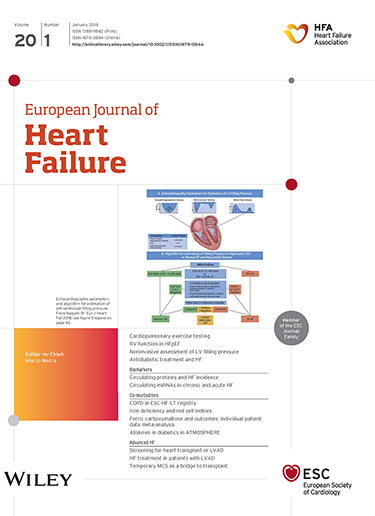Pathophysiology and clinical use of agents with vasodilator properties in acute heart failure. A scientific statement of the Heart Failure Association (HFA) of the European Society of Cardiology (ESC)
IF 16.9
1区 医学
Q1 CARDIAC & CARDIOVASCULAR SYSTEMS
引用次数: 0
Abstract
Acute heart failure (AHF) affects millions of people each year and vasodilators have been a central part of treatment for over 25 years. The haemodynamic effects of vasodilators vary considerably among individual agents. Some vasodilators, such as nitrates, primarily act on the venous system by redistributing the circulating blood volume away from the heart towards the venous capacitance system. Other vasodilators, such as nesiritide, lead to balanced vasodilatation in the arteries and veins, decreasing left ventricular afterload and preload. Considering mechanisms of action, intravenous vasodilators are thought to be effective in patients with AHF, particularly in those with acute pulmonary oedema, where increased cardiac filling pressures and elevated systemic blood pressures occur in the absence of, or with minimal systemic fluid accumulation. However, the 2021 European heart failure guidelines have downgraded the use of vasodilators due to two recent studies and several contemporary meta-analyses failing to show benefit in terms of survival. Thus, there remains no firm recommendation suggesting the use of vasodilator treatment over usual care. In addition, despite repeated efforts to develop new vasodilatory agents, no novel therapy has outperformed traditional AHF management. In parallel with the development of novel vasodilators, changing the design of clinical trials for AHF to consider phenotype diversity of AHF patients remains an unmet need. New randomized clinical trials should particularly focus on subgroups that may mechanistically derive benefit from vasodilators, which may entail moving enrolment of patients to clinical settings close to moment of decompensation, such as the emergency department.

血管扩张剂在急性心力衰竭中的病理生理学和临床应用。欧洲心脏病学会(ESC)心力衰竭协会(HFA)的科学声明
急性心力衰竭(AHF)每年影响数百万人,血管扩张剂已成为治疗的核心部分超过25年。血管扩张剂的血流动力学作用在不同的药物之间差别很大。一些血管扩张剂,如硝酸盐,主要通过将循环血容量从心脏重新分配到静脉容量系统而作用于静脉系统。其他血管扩张剂,如奈西立肽,可导致动脉和静脉血管舒张平衡,减少左心室负荷后和负荷前。考虑到作用机制,静脉血管扩张剂被认为对AHF患者有效,特别是急性肺水肿患者,在没有或只有极少的全身积液的情况下,心脏充盈压力增加和全身血压升高。然而,由于最近的两项研究和几项当代荟萃分析未能显示出在生存方面的益处,2021年欧洲心力衰竭指南降低了血管扩张剂的使用。因此,目前还没有明确的建议建议使用血管扩张剂治疗常规护理。此外,尽管一再努力开发新的血管舒张剂,但没有新的治疗方法优于传统的AHF治疗。在开发新型血管扩张剂的同时,改变AHF临床试验的设计以考虑AHF患者的表型多样性仍然是一个未满足的需求。新的随机临床试验应特别关注可能从血管扩张剂中获益的亚组,这可能需要将患者转移到接近失代偿时刻的临床环境,如急诊科。
本文章由计算机程序翻译,如有差异,请以英文原文为准。
求助全文
约1分钟内获得全文
求助全文
来源期刊

European Journal of Heart Failure
医学-心血管系统
CiteScore
27.30
自引率
11.50%
发文量
365
审稿时长
1 months
期刊介绍:
European Journal of Heart Failure is an international journal dedicated to advancing knowledge in the field of heart failure management. The journal publishes reviews and editorials aimed at improving understanding, prevention, investigation, and treatment of heart failure. It covers various disciplines such as molecular and cellular biology, pathology, physiology, electrophysiology, pharmacology, clinical sciences, social sciences, and population sciences. The journal welcomes submissions of manuscripts on basic, clinical, and population sciences, as well as original contributions on nursing, care of the elderly, primary care, health economics, and other related specialist fields. It is published monthly and has a readership that includes cardiologists, emergency room physicians, intensivists, internists, general physicians, cardiac nurses, diabetologists, epidemiologists, basic scientists focusing on cardiovascular research, and those working in rehabilitation. The journal is abstracted and indexed in various databases such as Academic Search, Embase, MEDLINE/PubMed, and Science Citation Index.
 求助内容:
求助内容: 应助结果提醒方式:
应助结果提醒方式:


